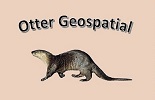We can define the location of a point on the earth’s surface by measuring its latitude and longitude. But that means there’s a fixed reference out there for us to measure from. The reference for a geographic coordinate pair is a mathematical approximation of the earth’s shape and size called a datum. So a bunch of smart people measure the earth, publish the model parameters and everyone goes home happy, right? Wrong! For a variety of cultural and technical reasons there are hundreds of datums in active use today. Each datum is the basis of a unique geographic coordinate system that will yield its own values of latitude and longitude for any given point. If you don’t believe me, go into the settings menu on your hand-held GPS receiver.
- Some systems are designed to support moderately accurate mapping over a large area, the entire earth if possible. Such systems are referenced to earth-centered datums.
- Some systems are designed to support more accurate mapping. To achieve the desired accuracy, it’s necessary to limit the system’s area of use. Such systems are referenced to local datums.
- New systems are published constantly as advances in geodesy (earth measurement) allow for the development of more accurate and/or site-specific datums
- Whether a particular user will update their current system to the latest and greatest depends on technical merit, budget considerations and whim. Many older systems remain in use long after publication of their intended replacements. The list of systems in use somewhere by someone keeps on growing.

Comments are closed.